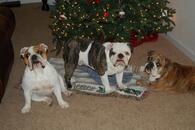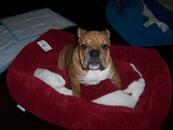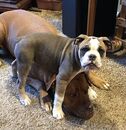In the last three years, HealthyStuff has conducted over 15,000 individual tests on over 5,000 common consumer products. We have tested toys, infant supplies, children's products, vehicles, children's car seats, pet beds and toys, and some apparel and accessories. The information on HealthyStuff represents the largest publicly available database of test data on toxic chemicals in consumer products. Currently, the U.S. government and product manufacturers are not providing this data to consumers. Our testing is not necessarily representative of all products on the market. In addition, the presence of a chemical in a product does not necessarily mean there is exposure.
Our sampling was conducted by the Ecology Center and our product testing partner organization, Citizens for Environmental Health - California.
HealthyStuff test data demonstrates that many products do not contain hazardous chemicals, proving that these chemicals of concern can be avoided. But hazardous chemicals are still far too commonplace in everyday consumer products. Consumers are faced with these unnecessary hazards in their homes, offices and vehicles.
Below is an overview of our recent sampling of consumer products.
Highlights of Pet Product Sampling
HealthyStuff tested over 400 pet products, including beds, chew toys, stuffed toys, collars, leashes, and tennis balls. Since there are no government standards for hazardous chemicals in pet products, it is not surprising that toxic chemicals were found.
45% of pet products tested had detectable levels of one or more hazardous chemical, including:
One-quarter of all pet products had detectable levels of lead.
7% of all pet products have lead levels greater than 300 ppm -- the current CPSC lead standard for lead in children's products.
Nearly half of pet collars had detectable levels of lead; with 27% exceeding 300 ppm -- the CPSC limit for lead in children's products.
One half (48%) of tennis balls tested had detectable levels of lead. Tennis balls intended for pets were much more likely to contain lead. Sports tennis balls contained no lead.
Pets are the canary in the coalmine in terms of chemical exposure. Cats groom themselves and lick off dust that has been shown to be heavily contaminated with hazardous chemicals. For example, bio-monitoring of cats has shown BFR exposure 23X higher than humans.
Highlights of Car Sampling
HealthyStuff tested nearly 700 new and used vehicles, from the 1980's to 2010 model year vehicles. Consumers can use the database to find the best and worst picks in every vehicle class.
US-made (produced in Ohio) Pontiac G5 & Chevy Cobalt rated best overall 2009 vehicle. The top rated manufacturers for 2009 were #1: Honda, #2 Smart and #3: Volvo; the lowest rated manufacturers were #1: Mitsubishi, #2: Audi and #3: VW
For the first time, older used cars were tested and pre-2004 vehicles tested significantly worse then 2009 vehicles. 2009 vehicle average scores were 1/3 better then vehicles manufactured before 2004. Most of this improvement is related to reduced use of heavy metals like lead in vehicles.
Levels of some chemicals found in vehicles are 5-10 times higher than in homes or offices. Since the average American spends more than 1.5 hours in their car every day, this can be a major source of toxic chemical exposure.
Highlights of Apparel & Accessories Findings
Jewelry, handbags and other types of accessories are the most likely to contain elevated levels of hazardous chemicals compared to other consumer products tested.
HealthyStuff tested over 100 women's plastic handbags and detected lead in over 75% of the bags analyzed. 64% of the bags contained lead over 300 ppm -- the CPSC limit for lead in children's products.Over half of the plastic handbags contain >1,000 ppm lead.
Highlights of Children's Car Seats Findings
ALWAYS USE CHILD SAFETY SEATS, REGARDLESS OF WHICH SEAT YOU USE. THESE SEATS SAVE LIVES
Infant & Child Car Seats contain chemical additives that can have adverse health impacts on babies and young children. Babies spend many hours in their carseats, sometimes even taking naps in them when they are not in the car.
Of the 60 car seats tested, over half (58%) contained one or more hazardous chemicals or materials tested for (including PVC, BFR's and heavy metals). Almost 1/3 (31%) of car seats tested contain Brominated Flame Retardents (BFRs).
There are healthy carseats without chemicals of concern! Carseats are necessary, but hazardous chemicals are not necessary to make a quality carseat for children and infants. A list of the best and worst car seats and examples of seats which have no PVC, lead or brominated flame retardants is available.
Highlights of Back-to-School Product Findings
HealthyStuff screened over 60 common back-to-school supplies, including backpacks, pencil cases, binders and lunchboxes.
Far too many back-to-school supplies are made of polyvinyl chloride (PVC) and contain lead. 56% were made out of PVC and 22% contained detectable levels of lead.
Overall 2/3 (68%) of back to school supplies contained one or more chemicals of concern.
2% of these products exceeded the CPSC standarrd for lead (300 ppm).
What can parents and consumers do?
HealthyStuff cannot test every product under the sun! Ultimately we must stop these toxic chemicals from entering our homes by urging product manufacturers and legislators to replace dangerous substances with safe alternatives immediately.
If we strengthen our chemical laws, not only will safer chemicals equal healthier families, but the Made in the USA label on our products will be a guarantee of a safer product, not a warning! This is not only about our health and safety, and the environment but about our prosperity.
Right now, we have a tremendous opportunity for positive change as Senator Frank Lautenberg and Representative Bobby Rush have said they will will soon be introducing a new bill to reform the outdated, toothless, Toxic Substances Control Act (TSCA), our federal law for regulating chemicals. To date, the EPA has only required testing on about 200 of the more than 80,000 chemicals that have been on the market since the law first passed in 1976. Meanwhile, the rates of asthma, diabetes, childhood cancers, infertility, and learning and behavior problems, conditions that have been linked in part to environmental exposures, have gone up. Clearly, the government has little authority to protect people from hazardous chemicals and the law is not working as intended.
Our sampling was conducted by the Ecology Center and our product testing partner organization, Citizens for Environmental Health - California.
HealthyStuff test data demonstrates that many products do not contain hazardous chemicals, proving that these chemicals of concern can be avoided. But hazardous chemicals are still far too commonplace in everyday consumer products. Consumers are faced with these unnecessary hazards in their homes, offices and vehicles.
Below is an overview of our recent sampling of consumer products.
Highlights of Pet Product Sampling
HealthyStuff tested over 400 pet products, including beds, chew toys, stuffed toys, collars, leashes, and tennis balls. Since there are no government standards for hazardous chemicals in pet products, it is not surprising that toxic chemicals were found.
45% of pet products tested had detectable levels of one or more hazardous chemical, including:
One-quarter of all pet products had detectable levels of lead.
7% of all pet products have lead levels greater than 300 ppm -- the current CPSC lead standard for lead in children's products.
Nearly half of pet collars had detectable levels of lead; with 27% exceeding 300 ppm -- the CPSC limit for lead in children's products.
One half (48%) of tennis balls tested had detectable levels of lead. Tennis balls intended for pets were much more likely to contain lead. Sports tennis balls contained no lead.
Pets are the canary in the coalmine in terms of chemical exposure. Cats groom themselves and lick off dust that has been shown to be heavily contaminated with hazardous chemicals. For example, bio-monitoring of cats has shown BFR exposure 23X higher than humans.
Highlights of Car Sampling
HealthyStuff tested nearly 700 new and used vehicles, from the 1980's to 2010 model year vehicles. Consumers can use the database to find the best and worst picks in every vehicle class.
US-made (produced in Ohio) Pontiac G5 & Chevy Cobalt rated best overall 2009 vehicle. The top rated manufacturers for 2009 were #1: Honda, #2 Smart and #3: Volvo; the lowest rated manufacturers were #1: Mitsubishi, #2: Audi and #3: VW
For the first time, older used cars were tested and pre-2004 vehicles tested significantly worse then 2009 vehicles. 2009 vehicle average scores were 1/3 better then vehicles manufactured before 2004. Most of this improvement is related to reduced use of heavy metals like lead in vehicles.
Levels of some chemicals found in vehicles are 5-10 times higher than in homes or offices. Since the average American spends more than 1.5 hours in their car every day, this can be a major source of toxic chemical exposure.
Highlights of Apparel & Accessories Findings
Jewelry, handbags and other types of accessories are the most likely to contain elevated levels of hazardous chemicals compared to other consumer products tested.
HealthyStuff tested over 100 women's plastic handbags and detected lead in over 75% of the bags analyzed. 64% of the bags contained lead over 300 ppm -- the CPSC limit for lead in children's products.Over half of the plastic handbags contain >1,000 ppm lead.
Highlights of Children's Car Seats Findings
ALWAYS USE CHILD SAFETY SEATS, REGARDLESS OF WHICH SEAT YOU USE. THESE SEATS SAVE LIVES
Infant & Child Car Seats contain chemical additives that can have adverse health impacts on babies and young children. Babies spend many hours in their carseats, sometimes even taking naps in them when they are not in the car.
Of the 60 car seats tested, over half (58%) contained one or more hazardous chemicals or materials tested for (including PVC, BFR's and heavy metals). Almost 1/3 (31%) of car seats tested contain Brominated Flame Retardents (BFRs).
There are healthy carseats without chemicals of concern! Carseats are necessary, but hazardous chemicals are not necessary to make a quality carseat for children and infants. A list of the best and worst car seats and examples of seats which have no PVC, lead or brominated flame retardants is available.
Highlights of Back-to-School Product Findings
HealthyStuff screened over 60 common back-to-school supplies, including backpacks, pencil cases, binders and lunchboxes.
Far too many back-to-school supplies are made of polyvinyl chloride (PVC) and contain lead. 56% were made out of PVC and 22% contained detectable levels of lead.
Overall 2/3 (68%) of back to school supplies contained one or more chemicals of concern.
2% of these products exceeded the CPSC standarrd for lead (300 ppm).
What can parents and consumers do?
HealthyStuff cannot test every product under the sun! Ultimately we must stop these toxic chemicals from entering our homes by urging product manufacturers and legislators to replace dangerous substances with safe alternatives immediately.
If we strengthen our chemical laws, not only will safer chemicals equal healthier families, but the Made in the USA label on our products will be a guarantee of a safer product, not a warning! This is not only about our health and safety, and the environment but about our prosperity.
Right now, we have a tremendous opportunity for positive change as Senator Frank Lautenberg and Representative Bobby Rush have said they will will soon be introducing a new bill to reform the outdated, toothless, Toxic Substances Control Act (TSCA), our federal law for regulating chemicals. To date, the EPA has only required testing on about 200 of the more than 80,000 chemicals that have been on the market since the law first passed in 1976. Meanwhile, the rates of asthma, diabetes, childhood cancers, infertility, and learning and behavior problems, conditions that have been linked in part to environmental exposures, have gone up. Clearly, the government has little authority to protect people from hazardous chemicals and the law is not working as intended.
Last edited by a moderator:




